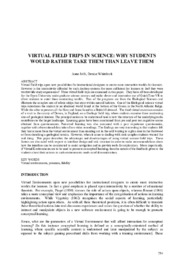Virtual field trips in science: why students Would rather take them than leave them
Abstract
Virtual Field trips open new possibilities for instructional designers to create more interactive worlds for learners. However is the interactivity afforded by such desktop systems for users sufficient for learners to feel they were worthwhile study experiences? Three virtual field trips are examined in this paper. They have all been developed for the Open University undergraduate science courses and make clever and innovative use of QuickTime VR to allow students to enter three contrasting worlds. Two of the programs are from the Biological Sciences and illustrate the complex sets of relationships that exist within natural habitats. One of the Biological science virtual trips introduces the student to an idealised world found at the bottom of the Ocean in the North Atlantic Ridge. While the other represents all the flora and fauna found in a British Oakwood. The third virtual excursion consists of a visit to the county of Devon, in England, on a Geology field trip, where students examine three contrasting sites of geological interest. The principal notion to be understood here is how the structure of the underlying rocks contributes to the larger landscape. Learning gains have been ascertained from pre and post test cognitive scores obtained from questionnaires. Perceived learning was also measured with a post experience questionnaire, together with observational data taken from video recordings. The findings are very interesting in that students felt they learnt more from the virtual environment than standing out in the cold waiting to sight a deer in the Oakwood or from sketching a geological terrain. However, when it came to dealing with rock samples students wanted the real thing. This paper describes the advantages and disadvantages of using virtual science field trips. These factors are discussed with respect to interface design and task structure in order to make recommendations about how the interface can be constructed to assist navigation and to provide tools for exploration. More importantly, if Virtual Environments are to be used to promote conceptual learning, then the nature of the feedback given to the students about their actions in such environments needs careful consideration.
